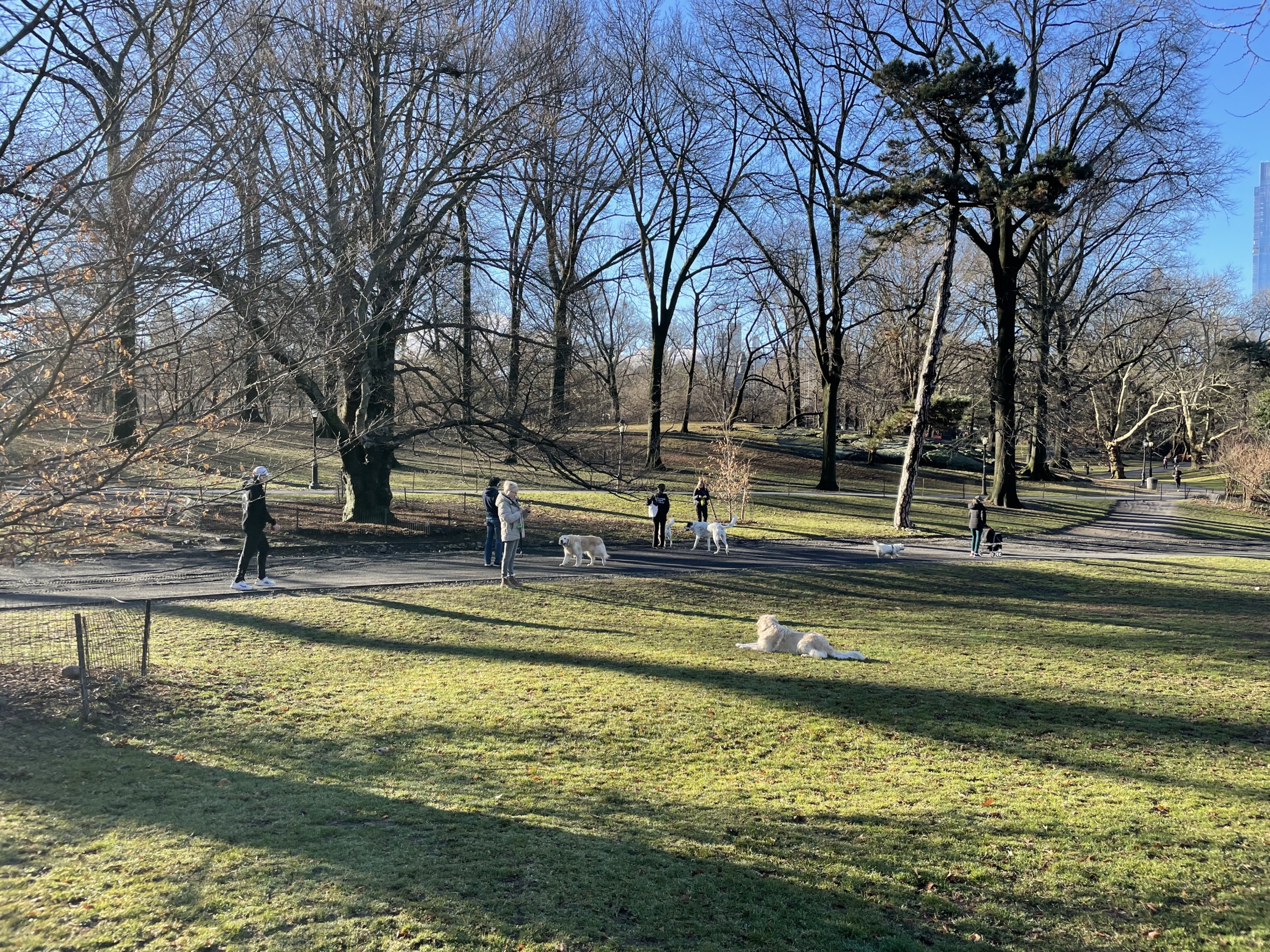
Monday, March 18, 2024
Cloudy. High 50 degrees. Falling temperatures this week.
Notices
Our calendar has lots of local events. Click on the link or the lady in the upper righthand corner to check.
Palm Sunday is on Sunday, March 24.
Upper West Side News
By Gus Saltonstall
The Central Park Conservancy is in the midst of a major restoration of the park’s outer sidewalks.
The nonprofit that oversees the park, armed with a budget of up to $64 million, is restoring the 108 blocks outlining the iconic park, according to The New York Times.
The project began last summer, and will include an examination of every sidewalk around Central Park, many of which are on the Upper West Side. For each block, there is a budget of up to $600,000 to fix any ailment found, the Times reported.
The entire span stretches about six miles. So far, 26 of the 108 blocks have been restored, with six currently in progress. The funding for the project comes from the city and the Conservancy.
The sidewalks were installed in the 1930s. “Hexagonal asphalt tiles were placed and granite blocks were laid out in intricate herringbone and basket-weave patterns, forming the distinctive path that is now traversed by 42 million visitors every year,” The New York Times wrote. “The main purpose of the park’s outer sidewalk was to ensure that the second you step onto it, ‘you realize you’re not in the city anymore,'” Elizabeth Smith, the president of the Central Park Conservancy, said.
There is not a set end date for the project. You can read more about the work being done on the New York Times website.
About a month ago, West Side Rag reported that employees at the Barnes & Noble on the Upper West Side had launched a unionization effort.
On Thursday, that dream became reality as employees of the bookstore chain’s location at 2289 Broadway (West 82nd-83rd) voted to join the Retail, Wholesale and Department Store Union.
The vote was lopsided, with 85 percent of the employees voting to join the union, making it the third Barnes & Noble in New York City to do so. There are about 50 employees at the location now part of the union, which will soon start drafting its first contract.
“Winning our union election means my and my co-workers’ needs can finally be heard!” Gina Fowler, a senior barista at the Upper West Side store said. “We’re asking for fair pay, clear opportunities to progress in long-term careers with Barnes & Noble, and overall job security. I look forward to having our voices heard at the bargaining table.”
An agreement was reached on Friday in the ongoing legal battle over New York City’s right-to-shelter rules, which were first enacted in 1981.
After multiple months, city officials reached a settlement with the Legal Aid Society and Coalition for the Homeless that adds new requirements for migrant adults arriving in New York City.
Here’s what to know.
- There are now limits for homeless adult migrants seeking shelter, including a 30-day shelter stay, and 60 days for adults 18-23.
- Shelter can now be denied to migrant adults who have exceeded those time limits and have not taken steps to find alternative housing or meet other exceptions.
- There will be no limits placed on families with children as long as the city is under a state of emergency related to the influx of migrants in the five boroughs.
You can learn more about the changes to the city’s right to shelter laws — HERE.
Thoughts from Florida and Learning to Drive
I’m in Florida for two weeks. I’ve seen multiple alligators, flamingos, ospreys, and a turtle crossing the road that left room for one or two punchlines.
On Saturday, we drove across the state from west to east. When I say “we,” I mean my Pennsylvania-born girlfriend drove while I sat in the passenger seat lending all the support I could. She, like almost every other person in the United States who did not grow up in New York City, learned how to drive between the ages of 15 and 16.
I have a New York-state learner’s permit that I got renewed last summer. It was a big deal for me.
At one point during the first couple of months of 2020 I got pretty close to getting my license. I completed the required five-hour class, and did six hours of driving lessons in Manhattan.
I would have made it to the needed 10 hours to take the test, but on two straight occasions, 30 minutes before my lesson was scheduled, my driving instructor texted me photos, which I’m 80 percent sure came from Google Images, of a flat tire, along with a note saying he wouldn’t be able to make it to the lesson.
Then March of 2020 hit — the world shut down – and I never got back to the lessons.
Lately, I’ve been feeling a stronger push to get a license, but struggling with acting on it. It is not that I need a car or would even get one living in the city, but the moments of guilt for not knowing how to get behind the wheel and help out on trips are adding up.
Whether it is the drive across Florida, a family road trip with my mom, or getting in the passenger seat with my 88-year-old grandpa behind the wheel, it is time to get a license. 28 years after I entered the world.
For any readers who learned to drive late — or are currently in the process of getting a license — or simply overcame a little bit of anxiety on the road to learning how to drive, any words of advice would be much appreciated.
Finally, check out our new tab, “About Us,” located below the masthead at the far right. It includes our history and profiles and photos of our regular contributors!
Subscribe to West Side Rag’s FREE email newsletter here.









Go Gus 🙂 Spend as much time driving outside of NYC as you can – at some point the thrill will overtake the anxiety and you’ll be comfortable behind the wheel. Find a non-threatening highway exit and practice getting on and off, over and over. Merging onto the highway is the most challenging aspect of driving and most new drivers don’t accelerate fast enough.
Re: “There will be no limits placed on families with children as long as the city is under a state of emergency related to the influx of migrants in the five boroughs.”
How many migrant families will be supported by the citizens while this “state of emergency” continues, and what are the conditions for declaring the “state of emergency” ended? 9 million families? No conditions for the end of the “emergency”?
I am glad there is some movement, but this right to shelter accorded to anyone from anywhere at the expense of people already struggling to live here is insane. The world and city are not what they are in 1981. Even back in the days of Ellis Island, immigrants entered legally and did not, AFAIK, get expenses paid by the citizens already here.
This has been going on a LOT longer than 1981. In the early 1930s, when the worldwide effects of the Great Depression sent – sound familiar – hundreds of desperate people to NYC, there were articles in the papers about women and children sleeping in the subways stations for shelter. Yup almost 100 years ago. (Those stories provided fodder for the labor activists then fighting to establish minimum wage laws – in industries (like hotel workers, or steam laundry workers), in state legislatures, and finally (1936 Fair Labor Standards Act) nationwide. ) Humane support for helpless people needing help to get settled and working has a long and worthwhile tradition in New York. And the migrants coming now, especially those in shelters, are not having easy time. (See articles on small kids selling candy in the subways.)
Children selling candy is child abuse. Children services should be involved and parents investigated, not rewarded by meal tickets.
I’m a first generation immigrant, came here in the 90s, and worked from day one as everyone else back then, be you from Georgia (country), Mexico, Ecuador, etc.
We had to work to make a life for ourselves. We were not given and didn’t expect handouts. All of us who wanted to work and make a life for ourselves, succeeded. There was a small percentage of immigrants whose goal was to get on welfare as soon as they got a lab official status, and they did that. This type managed to find any loophole to get temporary assistance till they are permanently on welfare. Today’s migrants do not need to do even that – they are given assistance right away! Why?!!
I worked all sorts of jobs like cleaning, dishwasher, porter till I saved enough money for school in the evenings. 7 years of working and studying, living in bad neighborhoods because that was all I could afford. Then slowly moved to a better area, and eventually to UWS. Now I have to pay taxes to house these migrants in a very expensive area for free! How unfair and frustrating is it!
From my personal experience and looking at today’s crowd, they are not looking for jobs. They can sometimes do menial cash jobs but mostly rely on government assistance.
People in this neighborhood don’t know the difference between legal hardworking immigrants and a bunch of freeloaders.
Asylum seekers are prohibited from working for 5 months! Crazy law. A lot of people working to change it. But you must know this affects so many of the migrants who first arrive. Was that true for you?
Trying to post response to the question address to me, so WSR please don’t censor again
Yes, it was for me and everyone else, the laws are still the same.
However you are missing my point entirely. No one was living for free on taxpayers buck regardless of their work permit status. You had to find someone to support you or you barter your services such as cleaning, babysitting, etc. for housing. Whoever was serious about becoming a functioning member of society, succeeded with no exceptions and no handouts. Whoever wanted to get on public assistance is still on public assistance and is proud of it.
Also, these migrants are actually working, for cash, hence scooters and such piling up near the shelters. Yet they are provided free housing and meals. Most of them as I mentioned do not and will not look for a legal taxable job. Most of them have relatives all over. The goal there is to stay on assistance even after getting a legal status.
I know what I’m talking about first hand. I don’t know where you are getting your information other than from the beaten up political slogans under the guise of compassion.
Virtually every country those claiming asylum are either outright prevented from working, and or restrictions are placed upon when they are able to be granted work permits.
France – six months: https://french-tax-lawyer.j2m-online.fr/talent-passport-france/work-france/can-an-asylum-seeker-work-in-france/#:~:text=You%20can%20apply%20for%20a,from%20having%20access%20to%20employment.
Germany – three months: https://handbookgermany.de/en/work-permit#:~:text=Self-employment%20is%20in%20principle,in%20an%20initial%20reception%20facility.
UK – Asylees are not permitted to work until their applications are approved. Government instead provides small stipend. https://www.gov.uk/government/publications/handling-applications-for-permission-to-take-employment-instruction/permission-to-work-and-volunteering-for-asylum-seekers-accessible#:~:text=Those%20who%20claim%20asylum%20in,they%20would%20otherwise%20be%20destitute.
Canada: Refugees are not permitted to work until and or unless granted work permit by government. Not an easy process. https://www.canada.ca/en/immigration-refugees-citizenship/services/refugees/claim-protection-inside-canada/work-study.html
Bottom line few if any industrialized countries allow “migrants” open and immediate access to legal work permits, and for very good reasons.
Amen. I posted a reply last night that was not printed, but you have said it better.
I hope the Barnes & Noble doesn’t close. Definitely a community anchor.
If a company as large as B&N can’t support unionized workers, the ethical balance is that the company shouldn’t exist.
Ah these evil big corporations again, how dare them, trying to maximize their profits. Saying everyone who never ran a business in their life.
You’ll probably get your wish. That sound you heard when this news was released was the trademark cackling laughter of one Jeff Bezos.
Over 230 million people in the USA have a valid drivers’ license. You can do it!
Hopefully they will replace all the dead and missing trees along the sidewalks around the park, especially on the west and north ends.
I am 56 and have never driven! Always lived in cities (Europe and US) and i’m against the car culture anyway. My partner and I rarely drive, we walk, bike and take public transport. Obviously, you can’t really do this in the US if you live outside of cities. My partner will teach me to do the bare minimum so I would be able to take him to the emergency room if – god forbid – it is necessary, or be able to know what to do if he – god forbid – gets a heart attack/stroke while driving.
Just wanted to share that you’re not alone. 🙂
Gus, I have been there. I even got a license but didn’t have enough practice so I forgot my barely there skills. Then I went to Florida thinking my friend would drive. She was even worse! So I had to, I was shaking every time, was afraid of highway exists and entrances, definitely didn’t drive at night. Somehow I made it, the whole week. Then I found a job where I had to drive. In 2 weeks I became a decent driver.
So… practice, practice, practice.
Re the Central Park sidewalks, I’ll bet that they’re doing the East Side first. The West Side walkways around the tennis courts have only been patched in decades, so they get uneven very quickly. Not so on the East Side, I think.
They have been working on the Fifth Avenue sidewalks for several months now. Yes, the UES gets sidewalks first and homeless shelters last. Why is this, I wonder? Cleaner food stores, too.
Gus – I grew up driving in a Chicago suburb – moved to a NY suburb – and then I (finally) in 2008 moved to the UWS and haven’t driven a car since! And haven’t missed it – Like to say I’m the useless grandma (don’t cook, don’t drive – suppose I have other redeeming characteristics) – That’s the great thing about living here in NYC – so much to do and enjoy without needing a car – and there are other options when you travel – So just be you –
South Florida is no place to learn to drive. You might acquire bad habits. The worst drivers in the country reside there. That’s why car insurance is 2-3 times more expensive there than even Manhattan.
Good luck with the driving, Gus!! If Autonautics is still in business, they were great – super patient, clear instructors, small group lessons (it actually helps to be the passenger of another learner, even if they are 15!) and good practice locations with virtually no traffic to practice in. Then, via friend or rental car, practice is highly recommended. Entrances and exits to parkways and highways; windy country roads; rain; dark; truck traffic, even parallel parking – this doesn’t all feel comfortable at once and “good driving judgement” doesn’t kick in right away, but with just a few low-stress local outings – you can start in good weather, going from quiet local streets to Jamaica Bay or up to Nyack – you will start to get the “feel” and be able to estimate the size of the vehicle you are in and it’s place on the road, and how to carefully judge speed and distance. Once you have that comfort, you can take years off, and still come back to it as you need to. But do this, for all the good reasons you mention, while you are still young and have excellent vision!
My extended family is multiple generation New Yorkers and several do not know how to drive.
One relative, then age 28 , got his license a few years ago but has not driven since.
Funny thing – on the way to the driving test, the driving school instructor had my relative drive on the Cross Bronx Expressway!!!
Two questions about repaving the sidewalks outside the park: (1) why in the world might it cost as much as $600,000 to repave a single block? (2) the principal reason for repaving is the growth of tree roots under the sidewalks, causing the sidewalks to buckle. Won’t repaving require removal of those roots and thereby kill those trees?